2024-05-02 ノースウェスタン大学
 To transform molybdenum into molybdenum carbide, the scientists needed a source of carbon. They discovered a cheap option in an unexpected place: the pantry. Surprisingly, sugar — the white, granulated kind found in nearly every household — served as an inexpensive, convenient source of carbon atoms
To transform molybdenum into molybdenum carbide, the scientists needed a source of carbon. They discovered a cheap option in an unexpected place: the pantry. Surprisingly, sugar — the white, granulated kind found in nearly every household — served as an inexpensive, convenient source of carbon atoms<関連情報>
- https://news.northwestern.edu/stories/2024/05/sugar-based-catalyst-upcycles-carbon-dioxide/
- https://www.science.org/doi/10.1126/science.adl1260
高温で安定な立方晶炭化モリブデン触媒が逆水-ガスシフト反応を促進 An active, stable cubic molybdenum carbide catalyst for the high-temperature reverse water-gas shift reaction
MILAD AHMADI KHOSHOOEI, XIJUN WANG, GERARDO VITALE, FILIP FORMALIK, […], AND OMAR K. FARHA
Science Published:2 May 2024
DOI:https://doi.org/10.1126/science.adl1260
Editor’s summary
A cubic phase of molybdenum carbide (α-Mo2C) can convert carbon dioxide to carbon monoxide (CO) at 100% conversion at 600°C. Although other phases of α-Mo2C have been used for this reverse water gas shift reaction, Ahmadi Khoshooei et al. describe a scalable synthesis of phase-pure α-Mo2C that is both highly active and highly stable. It maintains its activity for more than 500 hours under the high-temperature and high-throughput reaction conditions needed to make this endothermic reaction industrially scalable. The authors attribute the high activity in part to weak CO interactions with the surface and the presence of interstitial oxygen atoms. —Phil Szuromi
Abstract
Although technologically promising, the reduction of carbon dioxide (CO2) to produce carbon monoxide (CO) remains economically challenging owing to the lack of an inexpensive, active, highly selective, and stable catalyst. We show that nanocrystalline cubic molybdenum carbide (α-Mo2C), prepared through a facile and scalable route, offers 100% selectivity for CO2 reduction to CO while maintaining its initial equilibrium conversion at high space velocity after more than 500 hours of exposure to harsh reaction conditions at 600°C. The combination of operando and postreaction characterization of the catalyst revealed that its high activity, selectivity, and stability are attributable to crystallographic phase purity, weak CO-Mo2C interactions, and interstitial oxygen atoms, respectively. Mechanistic studies and density functional theory (DFT) calculations provided evidence that the reaction proceeds through an H2-aided redox mechanism.



